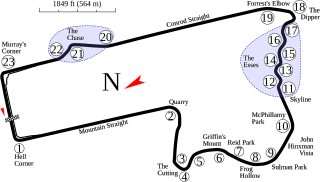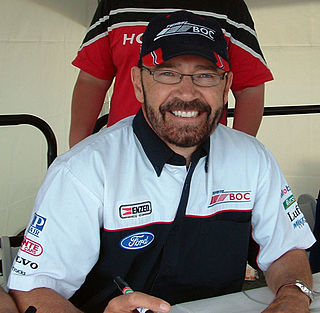
Touring car racing is a motorsport road racing competition that uses race prepared touring cars. It has both similarities to and significant differences from stock car racing, which is popular in the United States.

The Holden Monaro is a car that was manufactured by General Motors' Australian division Holden. It has a front-engine, rear-wheel-drive layout and was produced with a two-door coupé body from 1968 to 1975 and again from 2001 to 2006 and with a 4-door sedan body from 1973 to 1977.

The Bathurst 1000 is a 1,000-kilometre (621.4 mi) touring car race held annually on the Mount Panorama Circuit in Bathurst, New South Wales, Australia. It is currently run as part of the Supercars Championship, the most recent incarnation of the Australian Touring Car Championship. In 1987 it was a round of the World Touring Car Championship. The Bathurst 1000 is colloquially known as The Great Race among motorsport fans and media. The race originated with the 1960 Armstrong 500 with a 500 mile race distance at the Phillip Island Grand Prix Circuit; it was relocated to Bathurst in 1963 also with the 500 mile distance and has continued there every year since, extending to a 1,000 kilometer race in 1973. The race was traditionally run on the New South Wales Labour-Day long weekend in early October. Since 2001, the race has been run on the weekend following the long weekend, generally the second weekend of October.
The Australian Touring Car Championship (ATCC) is a touring car racing award held in Australia since 1960. The series itself is no longer contested, but the title lives on, with the winner of the Repco Supercars Championship awarded the trophy and title of Australian Touring Car Champion.

Jim Richards is a New Zealand racing driver who won numerous championships in his home country and in Australia. While now retired from professional racing, Richards continues to compete in the Touring Car Masters series.

Bradley Jones is an Australian former racing driver. Jones now acts as team co-principal with his brother Kim in the V8 Supercar racing team, Brad Jones Racing.
Robert Frederick Jane was an Australian race car driver and prominent entrepreneur and business tycoon. A four-time winner of the Armstrong 500, the race that became the prestigious Bathurst 1000 and a four-time Australian Touring Car Champion, Jane was well known for his chain of tyre retailers, Bob Jane T-Marts. Jane was inducted into the V8 Supercars Hall of Fame in 2000.
Garry Rogers Motorsport is an Australian motor racing team. It is owned by retired racing driver Garry Rogers who began the team to further his own racing efforts. Based in Melbourne, originally out of a Nissan dealership owned by Rogers, the team has competed in a variety of touring car series in Australia ranging from relatively modest Nissan production cars to Chevrolet NASCAR race cars to building the GT specification Holden Monaro 427C. The team won the Bathurst 1000 in 2000 and also won both of the Bathurst 24 Hour races which were held in 2002 and 2003. In 2013 the team celebrated its 50th year in racing since Rogers made his debut.

John Philip Bowe is an Australian racing driver, presently racing a Holden Torana in the Touring Car Masters series.
The 1970 Australian Touring Car Championship was a CAMS-sanctioned motor racing title for drivers of Group C Improved Production Touring Cars and Group E Series Production Touring Cars. The title, which was the 11th Australian Touring Car Championship, began at Calder Park Raceway on 22 March 1970 and ended at Symmons Plains Raceway on 15 November after seven heats.

The Holden HQ series is a range of automobiles that was produced by Holden in Australia from 1971 to 1974. The HQ was released on 15 July 1971, replacing the Holden HG series. It was the first ground-up redesign of the Holden line since its original release in 1948, and included an all-new body, chassis, and suspension. The HQ was later developed into a series of successor models, finally ending production when the WB series was discontinued in 1985.
The 1971 Australian Touring Car Championship was a CAMS-sanctioned motor racing title for drivers of Group C Improved Production Touring Cars and Group E Series Production Touring Cars. The title, which was the 12th running of the Australian Touring Car Championship, began at Symmons Plains Raceway on 1 March 1971 and ended at Oran Park Raceway on 8 August after seven heats.
Ian Anthony "Pete" Geoghegan, was an Australian race car driver, known for a quick wit and natural driving skills. Sometimes referred to as "Pete" Geoghegan, he was one of the iconic characters of the 1960s and 1970s Australian motor racing scene. His older brother Leo was also an accomplished driver and the brothers often shared a car in endurance events.
The Ford works team was the unofficial name for an Australian motor racing team which was supported by the Ford Motor Company of Australia. The team was formed in 1962 and was disbanded when Ford Australia withdrew from motor racing at the end of 1973. Drivers for the works team included Allan Moffat, Fred Gibson, Harry Firth, Bob Jane, Barry Seton, Bruce McPhee, John French, Ian Geoghegan and his brother Leo Geoghegan. Ford Australia also supported a factory rally team in Australia from 1977 to 1980.
The 1965 Australian Touring Car Championship was a CAMS sanctioned motor racing title open to Group C Improved Production Touring Cars. It was contested over a single 40-lap race staged at Sandown Raceway in Melbourne, Victoria, Australia on 11 April 1965. It was the sixth Australian Touring Car Championship title to be awarded and the first to be contested by cars complying with Group C regulations.

The 1966 Australian Touring Car Championship was a CAMS sanctioned Australian motor racing title open to Group C Improved Production Touring Cars. It was contested over a single 20-lap race staged at the Mount Panorama Circuit near Bathurst in New South Wales, Australia on Easter Monday, 11 April 1966, and was the seventh running of the Australian Touring Car Championship. The race was sponsored by the Neptune Oil Company, Sydney.
The 1963 Australian Touring Car Championship was a CAMS sanctioned motor racing title for drivers of Appendix J Touring Cars. It was contested over a single 25 lap, 50 mile (80 km) race at the Mallala Race Circuit in South Australia on 15 April 1963 and was the fourth running of the Australian Touring Car Championship. The race was won by Bob Jane, driving a Jaguar Mark 2 4.1.
The 1972 Australian Touring Car Championship was a CAMS sanctioned national motor racing title open to Group C Improved Production Touring Cars and Group E Series Production Touring Cars. The championship, which was the 13th running of the Australian Touring Car Championship, began at Symmons Plains and ended at Oran Park after eight rounds.
James Walter McKeown was an Australian racing driver who competed in the Australian Touring Car Championship from 1964 to 1972, with a best finish of 2nd in the 1970 ATCC. McKeown was part of the successful Neptune Racing Team alongside Norm Beechey and Peter Manton. The team later became known as the Shell Racing Team and consisted of McKeown in a Porsche 911S, Beechey in a Holden Monaro GTS350 and Manton in a Morris Cooper S.

The Holden Monaro 427C was an Australian built and designed GT style race car based on the Holden Monaro CV8 road car. The car ran in the Procar Australia-run Australian Nations Cup Championship and at the short-lived Bathurst 24 Hour race at the famous Mount Panorama Circuit in Bathurst.









